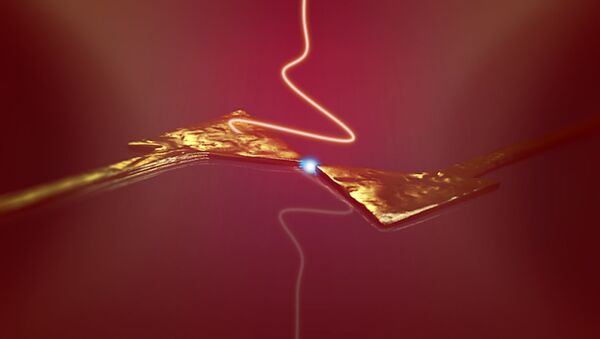A European team composed of researchers from the University of Konstanz, the University of Luxembourg, CNRS-Université Paris Sud, the Center for Materials Physics, and Donostia International Physics Center in San Sebastián, Spain, has found a way to transport electrons at times below the femtosecond range by manipulating them with light. The researchers believe their findings could have major implications for the future of data processing and computing.
“This may well be the distant future of electronics,” said University of Konstanz’s Professor Alfred Leitenstorfer, co-author of a paper published in the journal Nature Physics. “Our experiments with single-cycle light pulses have taken us well into the attosecond range of electron transport.”
In the study, Professor Leitenstorfer and colleagues aimed to develop an experimental set-up for manipulating ultrashort light pulses at femtosecond scales below a single oscillation cycle, and to create nanostructures suited for high-precision measurements and the manipulation of electronic charges.
Contemporary electronic components, which are traditionally based on silicon semiconductor technology, can be switched on or off within picoseconds. Standard mobile phones and computers work at maximum frequencies of several gigahertz while individual transistors can approach one terahertz.
The laser used by Leitenstorfer’s team was able to push out one hundred million single-cycle light pulses every single second in order to generate a measurable current. Using nanoscale gold antennae in a bowtie shape, the electric field of the pulse was concentrated down into a gap measuring just six nanometres wide (six thousand-millionths of a metre). Thus, the researchers could switch electric currents at well under a femtosecond – less than half an oscillation period of the electric field of the light pulses.
Using the insanely fast oscillations of light to help electrons pick up speed could provide new avenues for pushing the limits on electronics – and potentially offer insights into quantum computing. "This is very basic research we are talking about here and may take decades to implement," Leitenstorfer said.
Eventually, Leitenstorfer and his team think that the limitations of today's computing systems could be overcome using plasmonic nanoparticles and optoelectronic devices, using the characteristics of light pulses to manipulate electrons at super-small scales.
The researchers are hoping the study will open up new opportunities for understanding how light interacts with condensed matter, enabling observation of quantum phenomena on new temporal and spatial scales. Building on the new approach to electron dynamics, the researchers will move on to investigate electron transport at atomic time and length scales in even more sophisticated solid-state devices with picometer dimensions.



